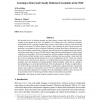2033 search results - page 370 / 407 » Semi-Supervised Support Vector Machines |
BMCBI
2006
13 years 7 months ago
2006
Background: Recursive Feature Elimination is a common and well-studied method for reducing the number of attributes used for further analysis or development of prediction models. ...
CORR
2006
Springer
13 years 7 months ago
2006
Springer
Many real life problems require the classification of items into naturally ordered classes. These problems are traditionally handled by conventional methods intended for the class...
BMCBI
2007
13 years 7 months ago
2007
Background: Classification studies using gene expression datasets are usually based on small numbers of samples and tens of thousands of genes. The selection of those genes that a...
IPM
2008
13 years 7 months ago
2008
Many machine learning technologies such as support vector machines, boosting, and neural networks have been applied to the ranking problem in information retrieval. However, since...
JMLR
2006
13 years 7 months ago
2006
We describe the use of machine learning and data mining to detect and classify malicious executables as they appear in the wild. We gathered 1,971 benign and 1,651 malicious execu...

